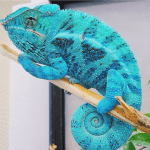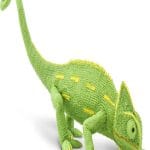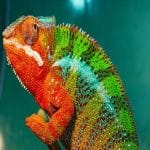When I brought home my first veiled chameleon, Sebastian, I made a rookie mistake—I placed him in a cage without proper chameleon plants. Two weeks of refusing to eat and constant stress coloration later, I realized my error.
After consulting with three local breeders and completely redesigning his habitat with appropriate chameleon plants, Sebastian transformed into a completely different animal—active, eating well, and displaying his gorgeous natural colors.

That experience taught me a valuable lesson: chameleon plants aren’t just decoration; they’re essential for your pet’s wellbeing.
Why Natural Chameleon Plants Are Non-Negotiable for Your Pet’s Health
“Chameleons don’t just live on plants; they live in them,” explained John Morris, a breeder I consulted who’s been raising chameleons for 15 years. “In the wild, they spend nearly their entire lives surrounded by vegetation.”

Live plants serve five critical functions in a habitat:
- Hydration sources – Chameleons often won’t drink from bowls, preferring water droplets on leaves of chameleon plants
- Security and stress reduction – Dense foliage from chameleon plants provides essential hiding places
- Humidity regulation – Chameleon plants naturally release moisture through transpiration
- Temperature gradients – Foliage creates varied microclimates within the cage
- Natural climbing structures – Different chameleon plants provide diverse textures and gripping surfaces
The Four Essential Chameleon Plant Types Every Habitat Needs
Through trial and error with Sebastian and later with my two other chameleons, I’ve discovered that the most effective habitats incorporate four distinct plant categories:
1. Centerpiece Chameleon Plants: The Backbone of Your Habitat

These larger chameleon plants provide the primary structure and climbing frame for your pet. Based on my experience, these work exceptionally well:
- Ficus benjamina (Weeping Fig) – Sebastian’s favorite perching spot is on the upper branches of his ficus. I’ve noticed this chameleon plant is particularly resilient to chameleon traffic and provides excellent climbing opportunities.
- Schefflera arboricola (Umbrella Plant) – When I added this chameleon plant to my female veiled’s enclosure, I was amazed at how quickly she claimed the highest branches as her basking spot.
- Pachira aquatica (Money Tree) – The braided trunk of this chameleon plant creates natural climbing paths. My panther chameleon regularly sleeps among its broad leaves.
2. Trailing Chameleon Plants: Nature’s Curtains

These cascading chameleon plants create privacy screens and drinking surfaces throughout the habitat:
- Epipremnum aureum (Pothos) – Hands down the MVP of chameleon plants. I’ve mounted pothos plants on three sides of Sebastian’s enclosure, and he regularly drinks from the leaves after misting.
- Chlorophytum comosum (Spider Plant) – The dangling “babies” produced by this chameleon plant create fascinating exploration opportunities. My youngest chameleon spends hours investigating these natural toys.
3. Wall Cover Chameleon Plants: Breaking the Barriers

These chameleon plants help eliminate the artificial feel of cage walls:
- Ficus pumila (Climbing Fig) – After adding this chameleon plant to cover the back wall of my enclosures, I noticed significantly reduced glass-dancing behavior in all three chameleons.
- Nephrolepis exaltata (Boston Fern) – The delicate fronds of this chameleon plant create depth and dimension, plus their high transpiration rate helps maintain healthy humidity levels.
4. Accent Chameleon Plants: Adding Interest and Variety

These smaller chameleon plants create visual and textural diversity:
- Hypoestes phyllostachya (Polka Dot Plant) – The distinctive spotted leaves of this chameleon plant add color variation. Plus, it’s native to Madagascar—just like many chameleon species!
- Tradescantia zebrina (Wandering Jew) – The purple undersides of these leaves create beautiful color contrasts that seem to fascinate my chameleons.
My Personal Experience: Chameleon Plants That Have Been “Taste-Tested”
A common concern I hear from fellow chameleon keepers is: “What if my chameleon eats the plants?”
Through keeping three different chameleons over five years, I’ve observed them occasionally nibbling on chameleon plants. Despite what some online lists suggest, I’ve never had a chameleon show any negative effects from tasting these specific chameleon plants:
- Pothos (Sebastian regularly takes small bites)
- Schefflera (occasional nibbling, especially new growth)
- Hibiscus flowers (my female veiled chameleon’s occasional treat)
- Ficus benjamina (rarely, but sometimes sampled)
Creating the Ultimate Chameleon Plant Arrangement

After numerous habitat redesigns, I’ve found the most successful strategy is mounting chameleon plants along the sides rather than using centerpiece plants on the cage floor.
Here’s why:
- Better hygiene – Eliminates dark, damp areas where bacteria thrive
- Improved air circulation – Prevents respiratory issues
- Easier maintenance – Simplifies cleaning and chameleon plant care
- Enhanced visual barriers – Creates more effective privacy screens
- Maximized usable space – Provides more climbing and perching options
FREE DOWNLOAD: My Chameleon Plants Cheat Sheet

Want to skip the years of trial and error I went through? I’ve created a printable chameleon plants cheat sheet that includes:
- The top 10 proven-safe chameleon plants with identification photos
- Care requirements for each chameleon plant
- Best placement strategies for various chameleon plants
- “Chameleon-tested” indicators from my personal experience
- Light and watering guidelines for optimal chameleon plant health
Conclusion: Transform Your Chameleon’s Life With the Right Chameleon Plants
The difference proper chameleon plant selection makes in a chameleon’s life is truly remarkable. When I completely overhauled Sebastian’s habitat with appropriate live chameleon plants, his transformation from a stressed, non-eating chameleon to a vibrant, active pet happened within just two weeks.
Remember that chameleons have evolved over millions of years to live among specific types of vegetation. By recreating a slice of their natural environment with thoughtfully selected chameleon plants, you’re not just decorating a cage—you’re providing the foundation for your chameleon’s physical and psychological wellbeing.
Start with the four chameleon plant categories I’ve outlined, focusing first on securing a good trailing plant like pothos for drinking surfaces and a sturdy centerpiece or wall chameleon plant for climbing and hiding. Then gradually add accent chameleon plants to create a diverse, enriching environment that will keep your chameleon happy and healthy for years to come.
Your chameleon will thank you with vibrant colors, active behavior, and a longer, healthier life—just as Sebastian has shown me.
FAQ
Do chameleons eat plants?
Chameleons generally eat insects such as locusts, mantids, grasshoppers, stick insects, and crickets. Some larger chameleons also eat small birds and other lizards. A few have been known to eat a bit of plant material.
How do I clean chameleon plants before putting them in my chameleon’s cage?
I always follow a three-step process: First, I gently rinse all foliage under lukewarm water to remove dust and surface residue. Next, I soak the entire chameleon plant (pot and all) in a clean water bath for 15-20 minutes. Finally, I rinse thoroughly again and allow the chameleon plant to dry completely before installation. If you’re concerned about pesticides, you can also replace the top 1-2 inches of soil with fresh, organic potting mix.
Can you put fake plants in a chameleon cage?
You can use fake plants in a chameleon cage, but they should supplement (not replace) live plants. Fake plants don’t provide humidity benefits or drinking surfaces that chameleons need. If using artificial plants, choose high-quality silk varieties without sharp wire edges that could harm your pet.
Can I put a frog with my chameleon?
Chameleons should never be housed with frogs or any other animals. The different environmental needs, potential disease transmission, and stress from interspecies interactions can be harmful to both animals. Chameleons are solitary, specialized reptiles that require their own dedicated habitat to thrive.







